






















|
CARAT cocktails in
whites
by Miss Terry Diner
USS Rushmore, moored at Sattahip, was the venue for the
annual CARAT cocktail party attended by Admiral Chai and Vice Admiral Sutat,
the top brass from the Royal Thai Navy, and civic notables from Pattaya. The
hosts were the resplendently attired American Navy personnel, their crisp
white uniforms looking for all the world like the “after” advertisement
for a new brand of laundry detergent. Immaculate to a man (and woman)
complete with the regulation three creases down the back of every
super-starched white shirt, they were magnificent hosts. While waiting to be
served, we visited the bar, where the wonderful bar staff were dispensing
Californian wine and American beer. The sparkling chardonnay was an amusing
drop and by the sixth glass positively hilarious.
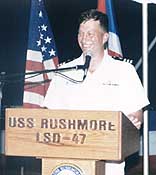 Cmdr
Peter Fanta, commanding officer of the USS Rushmore (LSD 47) greets quests
during the CARAT reception Cmdr
Peter Fanta, commanding officer of the USS Rushmore (LSD 47) greets quests
during the CARAT reception
Commander Peter Fanta, the Commanding Officer of the USS
Rushmore, welcomed everyone on board his ship and in a jocular way promised
everyone a ride on one of his million dollar LCAC’s (Landing Craft Air
Cushioned, silly) but reneged later in the evening, probably after a stern
warning from Rear Admiral Mark Edwards, a tall imposing be-whited American
with several tons of gold braid on each shoulder.
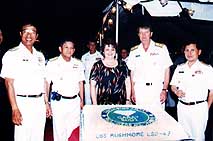 (L
to R) Thai Navy Cmdr Adm. Chai Suwanaparp, Sattahip Naval Base Cmdr Vice
Adm. Sutat Kayim, Minister Counselor and Deputy Chief of Mission at the U.S.
Embassy in Bangkok Marie T. Huhtala, Rear Adm. Mark Edwards and Rear Adm.
Takerngsak Wangkaew about to cut the “CARAT” cake. (L
to R) Thai Navy Cmdr Adm. Chai Suwanaparp, Sattahip Naval Base Cmdr Vice
Adm. Sutat Kayim, Minister Counselor and Deputy Chief of Mission at the U.S.
Embassy in Bangkok Marie T. Huhtala, Rear Adm. Mark Edwards and Rear Adm.
Takerngsak Wangkaew about to cut the “CARAT” cake.
But it was the laden food tables we had come to try.
Pondering over the prawns I found Mrs. Premrudee Jitthivutikan, the YWCA
President and owner of King Seafood in South Pattaya, who pronounced that
the American shrimps were on a par with those from her restaurant. And they
were. The suckling pig was also well cooked and the smartly dressed waiters
were also handing out a particularly fine scotch egg. We finished up with a
cheese platter, again a very popular item.
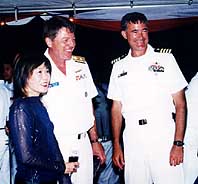 Rear
Adm. Mark Edwards (center) and Commodore of the CARAT Task Force, Captain
Gary Erickson (right) - CARAT gives US leaders a chance to build military to
military ties with their Thai counterparts, and make friends with local
citizens and business owners. Rear
Adm. Mark Edwards (center) and Commodore of the CARAT Task Force, Captain
Gary Erickson (right) - CARAT gives US leaders a chance to build military to
military ties with their Thai counterparts, and make friends with local
citizens and business owners.
While the US-Navy 7th Fleet’s Rock ‘n Roll Band, the
“Orient Express”, under the command of Musician Master Chief Rob Roy
played, we were addressed by Rear Admiral Mark Edwards and then the
ceremonial dessert CARAT cake was cut by the Thai and American Navy
Commanders, making sure none of the high calorie cake icing got on any
spotless whites. The sponge was moist and the icing simply scrumptious!
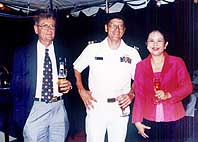 Lt.
Cmdr John Romero (center) with Peter Thorand (left) of the Rotary and Mrs.
Premrudee Jitthivutikan (right), president of the YWCA. Peter Thorand works
with US naval officers like John Romero, making sure sailors and marines
have fun and stay busy. Lt.
Cmdr John Romero (center) with Peter Thorand (left) of the Rotary and Mrs.
Premrudee Jitthivutikan (right), president of the YWCA. Peter Thorand works
with US naval officers like John Romero, making sure sailors and marines
have fun and stay busy.
However, there had to be some serious side to the evening
on board ship, with the Commodore of the CARAT Task Force, Captain Gary
Erickson being quick to point out on the Pattaya Mail Channel News that the
COMRELS (Community Relations exercises) were an important part of the CARAT
visits, even though the main thrust was strategic defense missions between
the associated nations.
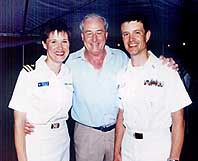 Lt.
Leslie Hull-Ryde (left), public affairs officer, and Master Chief Rob Roy
(right), leader of the Orient Express Band. The two officers did an
outstanding job booking the US Navy Seventh fleet’s Orient Express Band
for concerts throughout Pattaya. The eight-man rock ‘n roll band played in
shopping areas, local schools, and at the orphanage. Yes, that’s Doc in
the middle. Lt.
Leslie Hull-Ryde (left), public affairs officer, and Master Chief Rob Roy
(right), leader of the Orient Express Band. The two officers did an
outstanding job booking the US Navy Seventh fleet’s Orient Express Band
for concerts throughout Pattaya. The eight-man rock ‘n roll band played in
shopping areas, local schools, and at the orphanage. Yes, that’s Doc in
the middle.
The party finished with some of the crew dancing to the
band’s repertoire of Rock and Roll Music (lyrics and score Chuck Berry),
but Madame and I bade our farewells and were escorted off the vessel by some
lovely young Marines and safely placed in our chauffeur driven Mercedes for
the leisurely trip back to Pattaya. If you can wangle an invitation next
year, do go. Highly recommended.
USS Rushmore, Sattahip Docks, no credit cards.
The Orient Express bowls
‘em over
The seventh fleet US Navy band, the Orient Express, under
the charge of Musician Master Chief Rob Roy has been wowing the locals and
tourists all over Pattaya with their very professional brand of music.
 Boogie
down to the US Navy beat! Boogie
down to the US Navy beat!
With gigs in Walking Street, Big C, the Royal Garden
Plaza and the Amari Orchid Resort in front of the Henry J Bean’s Bar and
Grill, it was a hectic four day schedule for the navy musicians, but a
schedule they obviously relished.
There was no doubt about the band’s ability to get the
crowds to their feet and dance their cares away to a huge variety of musical
styles (and a corresponding number of dancing styles as well). Even young
Christopher Haeberli, who celebrated his 8th birthday at the Amari venue,
was seen beating time with his birthday cake fork. It was just that kind of
music and that kind of night.
Lieutenant Lesley Hull-Ryde from the Public Affairs
Department of the US Navy was thrilled at the response from Pattaya for the
Orient Express, and many locals expressed the hope that they would be back
next year during the CARAT exercises.
U.S. Navy doc treats
Thai patients
Story and photos by Ensign Christina Skacan,
CARAT Public Affairs
Fortunately Lt. Amy Rindfleisch loves children. Solo, she
treated approximately 100 of them without X-ray machines, nurses or labs.
Like all doctors, Rindfleisch made the rounds, seeing her
Thai patients as part of a medical and dental civic action project during
the Navy’s premier bilateral exercise here known as Cooperation Afloat
Readiness and Training, or CARAT.
“It’s challenging to perceive the interaction from
the child’s point of view - a lot of things they perceive as scary,”
said Rindfleisch, a native of Exeter, N.H. Many of the children had never
before seen an American, let alone an American doctor.
 Doc
Amy with a very young patient Doc
Amy with a very young patient
“If you can get a child to smile, to laugh, it’s a
lot of fun and very rewarding.”
The U.S. Navy sent three doctors and a dentist to treat
more than 400 medical patients and almost 100 dental patients, extracting
120 teeth in eight hours. Royal Thai Navy medical professionals helped
translate so Rindfleisch and the American team could really talk with their
patients.
She diagnosed flu, pneumonia, upper respiratory illnesses
like asthma, rashes and scabies. Scabies result when microscopic mites
burrow under the skin, causing an itchy reaction and detected by scratch
marks.
“We saw whoever showed up, villagers young and old.”
One patient suffered from a painful furuncle, a little walled off ball of
pus under the skin, requiring drainage. Rindfleisch lanced it with a
scalpel.
“In the clinic we’d do a culture, lab work, things we
do not have time to wait for. It’s different out here. We just read the
symptoms. It’s a little like shooting from the hip.”
A Boston University grad, Rindfleisch completed her
residency at Connecticut Children’s Hospital then shipped out to United
States Naval Hospital, Okinawa, Japan. She currently serves in the Navy in
exchange for a scholarship she received for her four years of medical
school.
“This is an opportunity for the Thai people to receive
free medical care and supplies they could not otherwise easily obtain.”
Referred by the local Buddhist temple, Wat Soi 8,
villagers waited in long lines at Nikom 3 elementary school to receive
treatment and to fill their prescriptions for Tylenol, Robitussin,
multi-vitamins and other basic medications.
Wilai, 15, carried her sister, Kanongwan, younger than 2,
to see Rindfleisch. Through the translator, Wilai noted her sister’s
symptoms: running nose, cough, fever, very sore throat and diarrhea.
“Times like these it’s good to fall back on
experience,” noted Rindfleisch.
Working without the typical clinical support, the doctors
used many visual diagnoses.
Rindfleisch says she’s grateful for the clinical
support she gets at Naval Hospital,Okinawa - or anywhere in the United
States.
“One thing that frustrated me the most was I will not
be able to follow up on chronic cases, like asthma, which need continual
care.”
Whether or not the Thai villagers will have the money for
- or the access to - quality medical care concerns the doctor. Without
preventive care and maintenance of chronic cases, the overall health of the
sick villagers will not improve.
Rindfleisch will serve three more years in the Navy, then
decide on her future. A colleague recently asked her what she will do when
she leaves the Navy.
“Who says I am getting out?”
Sailors reach out to
Thais
Story and photos by Ensign Christina Skacan,
CARAT Public Affairs
The Ban Nok School sits nestled amid trees and grass
behind a tiny town in southern Thailand.
Sailors from the annual Cooperation Afloat Readiness and
Training exercise, or CARAT, arrived on teachers’ day to paint, garden,
distribute food and play sports with the 120 students in grades one through
six.
“I like helping people. Sometimes you need to step
back, reflect and give back,” said MSC Anthony Warren of Detroit, Mich.
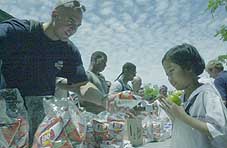 The
way to a child’s heart is through her stomach? The Comrel chip giveaway The
way to a child’s heart is through her stomach? The Comrel chip giveaway
Project Handclasp, organized by former naval personnel in
San Diego, Calif., gathers items from corporations and individuals to donate
to schools, orphanages, hospitals and temples throughout Southeast Asia.
Aided by the local Rotary Club, CARAT Sailors and Marines distributed books,
sewing machines, first aid supplies and hygiene products - more than nine
pallets of supplies - in Thailand alone.
“Community relations projects (Comrel) give Sailors and
Marines the opportunity to get to know the people, to learn about different
cultures and to do some good,” explained Lt. Ruth Rayburn, who organizes
community relations projects for CARAT. “The Thai people are so
appreciative, and the Sailors really do enjoy doing something worthy for
someone else.”
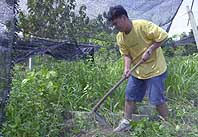 Students
plan to plant their own garden where the Sailors tilled the soil behind Ban
Nok School Students
plan to plant their own garden where the Sailors tilled the soil behind Ban
Nok School
CARAT forces participated in six separate community
relations projects in the countryside of southern Thailand. Navy Divers from
Mobile Diving and Salvage Unit One teamed with the local Mermaid Dive School
to clean Pattaya Bay. Sailors from each of the three surface ships
participating, USS Rushmore (LSD 47), USS Curts (FFG 38) and USS Wadsworth (FFG
9), as well as Landing Force CARAT Marines worked at local elementary
schools.
Students plan to plant their own garden where the Sailors
tilled the soil behind Ban Nok School and will be able to gather in a
freshly painted assembly room.
“It’s always nice to be around children because all
around the world children are the same - they are not bound by hate,”
noted GM1 Daniel Barbero, from Bronx, N.Y.
After completing their work, Sailors and students played
soccer, arm-wrestled and staged piggyback races. One Sailor turned around
after washing his hands to discover one Thai student wearing his shirt, one
painting with his paintbrush and a third videotaping everything with his
camera.
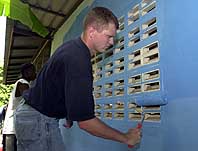 Making
the surroundings a little brighter Making
the surroundings a little brighter
“The children had a good time today,” said second
grade teacher Wanna Sangsuk.
While the Sailors and students worked and played
together, mothers prepared a colorful, aromatic feast of rice, vegetables,
fruits and tea. The school playing field bristled with Sailors, students,
teachers and parents laughing together.
“I’ve always enjoyed interacting with other
cultures,” said STG3 David Easterling, of Richmond, Va., who learned on
Father’s Day he will be a father in December.
“Everything we take for granted in the U.S. we can
appreciate more after meeting people from around the world. I love to help
out at these events.”
To end the day and bless the occasion, nine Buddhist
monks arrived to conduct a religious ceremony attended by Sailors, students
and parents. Sitting on the floor, shoes removed and legs crossed, Sailors
listened to the chanting and basked in the warm atmosphere of incense and
friendship - something they might only experience while on deployment as
part of CARAT.
CARAT, a series of bilateral exercises, takes place
throughout Southeast Asia every year. It aims to increase interoperability
and enhance regional cooperation. CARAT also gives Sailors and Marines a
chance to get to know other cultures and people throughout the Western
Pacific.
Countries participating this year include: Indonesia,
Singapore, Philippines, Malaysia, Brunei, and Thailand.
Whither Thai Education -
Or Wither Thai Education?
As the great education debate rages on at all levels of
Thai society, the advent of Child Friendly Schools could well be a panacea
to the classroom ills. Established by the Office of the National Primary
Education Commission (ONPEC), the Mahidol University’s Institute for
Nutrition Research and UNICEF, amongst others, a network of these schools
now exists in the north and northeast and is likely to become nation-wide
ultimately.
Story and photos by Peter Cummins
A number of rapid changes are overtaking the Thai
education system. The more traditional “chalk and talk” method and the
entrenched “rote” system of attaining knowledge are under strong attack
from the radical “child-centred learning” concept now being vigorously
promoted throughout the Kingdom’s schools.
 Meal
time at Kookard: a free lunch Meal
time at Kookard: a free lunch
Schemes such as the Rajhabat Institute’s alternative
learning centres being set up at department stores, in shophouses and, even,
the countless unfinished abandoned buildings blighting the Bangkok
cityscape, are further eroding the traditional system. This “shophouse
school” idea adds to the confusion and promotes quantity - rather than
quality - education.
Even at the governmental level, there is enormous
conflict, with the erstwhile Education Minister recently resigning in anger
over opposition and endless counter-proposals to his education reform bills.
Where are the rights of the child in all this confusion?
Is child-centred learning the answer? Or is the child being lost in the
midst of the controversies? It is, at least, a start but it has also driven
a wedge between teacher and student, tradition and change. The Education Act
of 1999 brought into force a child-centred education system aimed ideally to
promote creativity, independent thinking and to develop analytical skills.
Up until the promulgation of the Act, knowledge was imposed upon the student
body by the teachers who instructed their charges to commit tracts of text
to memory and accept, unquestioningly, old precepts, beliefs and values.
Now, it appears that education is a rudder-less ship upon
a turbulent sea: almost 700,000 teachers nation-wide - many of whom are
products of the “rote” method themselves - have to ‘re-learn” how to
teach. Probably more alarming, however, is the vast body of students who,
freed from traditional constraints by the Act, are unable to cope with a
self-imposed academic discipline and the new necessity of selecting reading
and studying priorities formerly set by the teachers. The bond which existed
in many schools between teacher and student is under severe stress.
Child Friendly Schools
But there is an alternative and it is taking root in a
most positive and fruitful manner. Known as the “Child Friendly School”
(CFS) concept, it was launched in the north and northeastern regions which,
in the course of just two years, has reached some 120 schools. By the end of
next year, the principals concerned expect that upwards of 200 schools will
be “child friendly”. Eventually, all primary, and even secondary
schools, could become part of the CFS network - perhaps becoming thereby,
the panacea for Thailand’s troubled schooling system.
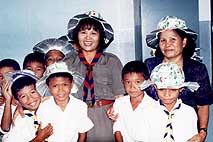 The
children make hats from their milk ration cartons The
children make hats from their milk ration cartons
The United Nations Children’s Fund (UNICEF), totally
dedicated to the welfare and well-being of children everywhere, strongly
advocates the “Convention on the Rights of the Child” which was adopted
unanimously by the United Nations General Assembly in 1989 and has
subsequently been implemented universally with just two countries refusing
to accede.
UNICEF, within the context of children’s rights related
to education, leisure and cultural activities, collaborated with the Thai
Government’s Office of the Primary Education Commission (ONPEC) and, in
1998, brought 400 young people together in a Children’s Assembly. Dr.
Kasama Varavan, the secretary-general of ONPEC, was astounded at the
revelations emanating from the Assembly “which,” Dr. Kasama said at the
time, “proved to be a turning point for teachers who, up until then, had
been beyond criticism”. The students’ comments were instrumental in
bringing them together with teachers, parents and community leaders
country-wide.
The Thailand Child Friendly School Programme was thus
launched by the Office of the National Primary Education Commission (ONPEC),
with the collaboration of the Art and Cultural Institute for Development
(MAYA), Save the Children (based in the USA), the Mahidol University’s
Institute for Nutrition Research, Save the Children and Life Skills
Foundation, as well as considerable financial and advisory assistance from
UNICEF.
The DFS philosophy, while incorporating much of the
child-centred education idea, rather steers a middle path between the
traditional and the new and aims particularly at bringing education to
disadvantaged children.
UNICEF feels that it is this group which most needs the
benefits, mental and physical advancement which education fosters. Yet,
ironically, it is the very children from this strata of society who have
been excluded from schools for a myriad reasons, not the least of which is
economic hardship. Many children from poor families, who may have been
fortunate to enrol in a school, are often obliged to drop out due to the
financial burden imposed on their parents by school fees, books, uniforms
and other expenses related to a child’s attendance.
This unfortunate trend has been clearly recognized by H.E.
Anand Panyarachun, the UNICEF Ambassador for Thailand who pointed out
recently, “That specific UNICEF-supported projects, such as assistance to
educating school drop-outs from poor families have been actively promoted by
the Thai Royal Family.” The creation of the CFS is at least a start to the
means of addressing this enormous problem.
Ban Kookard School
The Ban Kookard School, one of the five within the radius
of the Khon Kaen district is situated some 80 km south and is a viable - and
vibrant - example of the success of the CFS.
 The
Kookard School: a sea of happy faces The
Kookard School: a sea of happy faces
A child friendly school, according to the UNICEF
definition, is “A secure place where children can receive appropriate
health care as well as providing the most effective child-centred
learning.” The CFS promotes lively participation in all school activities
while respecting the rights of the child, in accordance with the clauses of
the Convention.
As one enters the spacious grounds of the Ban Kookard
School, the immediate impression is one of confidence, enthusiasm and a zest
for life. Everywhere – in the school grounds, in the recreation areas, in
the classrooms – a sea of smiling faces exudes the exuberance of these
children.
The Kookard School fulfils all the criteria of a CFS, by
protecting the rights of each student, promoting child participation and
ensuring a healthy, friendly environment. A key to the success of Ban
Kookard, as with any of the other schools, is an active student, teacher,
parent and community partnership working together to formulate values and
realistic goals. A school curriculum, jointly prepared, aims at developing
the individual’s life skills and preparing the child for a rewarding life
in the community.
 The
Kookard faculty members: everybody is happy The
Kookard faculty members: everybody is happy
No children have been rejected for admission to Kookard
and no child has ever been expelled. Quite the contrary, for a frequently
updated management information system (MIS) profiles every child -
background, parental status, subjects, skills and grades - and allows
teachers and supervisors to anticipate any potential conflict inherent in
the biodata.
Any form of physical punishment is strictly forbidden and
thus the children develop in an environment that carries no threat of
retribution. The CFS programme includes all children and, because many of
the schools are located in border areas, a special emphasis is placed on
admitting the disadvantaged and children from minority groups where language
becomes an impediment to learning.
The school provides education from primary one to
secondary three, for children aged seven to 15. Thereafter, the young adult
can go on to a vocational training or a trade school. Some have enrolled in
the nearby Chonnabot Community College where some enterprising CFS graduates
are running a college-wide radio programme, dealing with the gamut of
student problems and finding answers to their questions.
As Gamini Abeysekera, representative of the UNICEF Office
for Thailand said recently at UNICEF’s fiftieth anniversary of operations
in Thailand, “As the UNICEF ship, filled with funds and supplies,
technical assistance and communications material sails into the next fifty
years in a sea of children, let us wish it a safe voyage to embark on the
emerging challenges.”
Undoubtedly, the future of the Child Friendly Schools is
one of these major challenges. They could well be the answer to Thailand’s
monumental education problems.
Royal Heritage invests
in Thailand’s future
Computers for Thai Kids Project
Martin McNicholas and Malcolm Boden, directors of Royal
Heritage Asset Management donated a much-needed printer to the Pattaya
Computer Club’s ‘Computers for Thai Kids Project’. The idea came about
when Martin McNicholas met Glen ‘Jeep’ Holthaus and his wife Lek. Martin
happily donated a new color printer to them as a means giving something back
to the community.
 Martin
McNicholas (back row, 2nd right) on behalf of Royal Heritage Asset
Management, donates a much-needed color printer to the Pattaya Computer
Club’s “Computers for Thai Kids Project”, run by Jeep (back left) and
Lek (back right). Martin
McNicholas (back row, 2nd right) on behalf of Royal Heritage Asset
Management, donates a much-needed color printer to the Pattaya Computer
Club’s “Computers for Thai Kids Project”, run by Jeep (back left) and
Lek (back right).
After over 3 years of existence, the Computers for Thai
Kids Project is still going strong today and has quietly managed to support
over 80 children to continue their education where as under normal
circumstances the children would be forced to leave school due to financial
hardship. The project also donates computers to government schools
throughout the country to assist children in learning computer literacy,
which has become important in today’s ever growing computer age.
Jeep added, “We only give computers to schools where
there is someone who can use them and teach the children, as well as repair
them when something breaks down...” This idea ensures that it is the
children that receive the full benefit. Glen and Lek fund the entire program
by themselves through selling sandwiches and drinks at sporting events, such
as the regular Hash Run on Mondays. Any donated items are repaired and then
given to a government school.
The donation by Martin and Malcolm is the first color
printer that the project has received and will be put to good use by the
children, especially when comes to printing out letters and pictures, when
they start learning more about graphics programs. Many of the children go to
‘Jeep’s Joint’ after their school day to learn what they are unable to
in school. Many of the children are also “street kids”, who otherwise
would never get an education.
This worthwhile project will continue as long as there is
a constant supply of computers and funds to educate children in need. It is
certainly an investment in the future of the country.
If you would like to help Jeep and Lek with sponsorship,
computer or tuition you can contact them on 038-424 998 or email at [email protected]
The Origin of Dragons
by Suchard Krephitmai
These days we forget that in the middle ages no one
questioned that fact that dragons were real; they were considered
responsible for all natural disasters and other unexplainable phenomena.
No one ever sat pondering over the question where dragons
might originate. They were thought to have existed from the beginning of
time and they were a major topic of conversation.
During the 17th century scientists began to doubt the
real existence of dragons, but conceded that these creatures were at least
possible. A new question arose if they existed: how? The old Christian
explanations on the creation of the earth crumbled. Additionally there was
severe doubt whether such fierce animals were really God’s creatures. But
the Bible never explicitly mentioned the creative powers of the Devil. Could
there be another way for the origin of dragons?
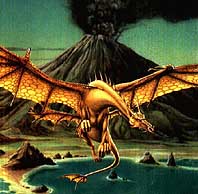 Golden
Dragon Golden
Dragon
In 1683 to 1691 Eberhard Werner Happel published his
Relationes Curisosae, a collection of curiosities. Of course Happel could
not ignore the dragon. He first presents the story of Deodatus de Gozon, a
young knight of St. John who killed a dragon on the isle of Rhodes in 1345.
Happel afterwards lists some well-known facts: Dragons are many fold - some
possess wings and others don’t, some have four and others two legs. Their
feet could be compared to those of goose, lions or eagles, but all dragons
are said to be venomous. But then he suddenly states that they are monsters
or miraculous creatures, which could not spring from an ordinary copulation
of two common animals of different species. (Of course he mentioned the mule
as an example of such a bastard.) And he gives the explanation: It is well
accepted that dragons inhabit the remotest dwellings such as caves, cliffs
or deserts. Only eagles, vultures and other birds of prey are their
companions. In fact they dwelled there even before the dragon. To these
places they brought their prey - snakes, birds, rabbits, lambs, dogs, and
even little children! - to lacerate and devour them. And there the remains
decayed. But still remnants of the semen of these unlucky victims survived.
Of course it was impossible that this seed could develop ordinary animals.
But through time the semen of various creatures would intermingle and at
last a kind of “fermentational putrefaction” would give birth to a
dragon. Logically, this dragon will show features of all animals involved:
head and tail of the snake, wings of a bird or bat, ears of a rabbit and
legs of whatever kind of being.
Happel certainly had not invented this strange and
peculiar theory. But where was it derived from?
There are still those out there today that believe in
dragons and make up stories and poems. Surrounded in mystery and legend, the
romance of the dragon is found in cultures all around the world.
Updated every Friday
Copyright 2001 Pattaya Mail Publishing Co.Ltd.
370/7-8 Pattaya Second Road, Pattaya City, Chonburi 20260, Thailand
Tel. 66-38 411 240-1, 413 240-1, Fax: 66-38 427 596
Updated by
Chinnaporn Sungwanlek, assisted by Boonsiri Suansuk.
E-Mail: [email protected]
|

The Rotary Club
of Jomtien-Pattaya

Skal
International

Pattaya
Fun City
By The Sea
|
 Cmdr
Peter Fanta, commanding officer of the USS Rushmore (LSD 47) greets quests
during the CARAT reception
Cmdr
Peter Fanta, commanding officer of the USS Rushmore (LSD 47) greets quests
during the CARAT reception (L
to R) Thai Navy Cmdr Adm. Chai Suwanaparp, Sattahip Naval Base Cmdr Vice
Adm. Sutat Kayim, Minister Counselor and Deputy Chief of Mission at the U.S.
Embassy in Bangkok Marie T. Huhtala, Rear Adm. Mark Edwards and Rear Adm.
Takerngsak Wangkaew about to cut the “CARAT” cake.
(L
to R) Thai Navy Cmdr Adm. Chai Suwanaparp, Sattahip Naval Base Cmdr Vice
Adm. Sutat Kayim, Minister Counselor and Deputy Chief of Mission at the U.S.
Embassy in Bangkok Marie T. Huhtala, Rear Adm. Mark Edwards and Rear Adm.
Takerngsak Wangkaew about to cut the “CARAT” cake. Rear
Adm. Mark Edwards (center) and Commodore of the CARAT Task Force, Captain
Gary Erickson (right) - CARAT gives US leaders a chance to build military to
military ties with their Thai counterparts, and make friends with local
citizens and business owners.
Rear
Adm. Mark Edwards (center) and Commodore of the CARAT Task Force, Captain
Gary Erickson (right) - CARAT gives US leaders a chance to build military to
military ties with their Thai counterparts, and make friends with local
citizens and business owners. Lt.
Cmdr John Romero (center) with Peter Thorand (left) of the Rotary and Mrs.
Premrudee Jitthivutikan (right), president of the YWCA. Peter Thorand works
with US naval officers like John Romero, making sure sailors and marines
have fun and stay busy.
Lt.
Cmdr John Romero (center) with Peter Thorand (left) of the Rotary and Mrs.
Premrudee Jitthivutikan (right), president of the YWCA. Peter Thorand works
with US naval officers like John Romero, making sure sailors and marines
have fun and stay busy. Lt.
Leslie Hull-Ryde (left), public affairs officer, and Master Chief Rob Roy
(right), leader of the Orient Express Band. The two officers did an
outstanding job booking the US Navy Seventh fleet’s Orient Express Band
for concerts throughout Pattaya. The eight-man rock ‘n roll band played in
shopping areas, local schools, and at the orphanage. Yes, that’s Doc in
the middle.
Lt.
Leslie Hull-Ryde (left), public affairs officer, and Master Chief Rob Roy
(right), leader of the Orient Express Band. The two officers did an
outstanding job booking the US Navy Seventh fleet’s Orient Express Band
for concerts throughout Pattaya. The eight-man rock ‘n roll band played in
shopping areas, local schools, and at the orphanage. Yes, that’s Doc in
the middle. Boogie
down to the US Navy beat!
Boogie
down to the US Navy beat! Doc
Amy with a very young patient
Doc
Amy with a very young patient The
way to a child’s heart is through her stomach? The Comrel chip giveaway
The
way to a child’s heart is through her stomach? The Comrel chip giveaway Students
plan to plant their own garden where the Sailors tilled the soil behind Ban
Nok School
Students
plan to plant their own garden where the Sailors tilled the soil behind Ban
Nok School Making
the surroundings a little brighter
Making
the surroundings a little brighter Meal
time at Kookard: a free lunch
Meal
time at Kookard: a free lunch The
children make hats from their milk ration cartons
The
children make hats from their milk ration cartons
 The
Kookard School: a sea of happy faces
The
Kookard School: a sea of happy faces
 The
Kookard faculty members: everybody is happy
The
Kookard faculty members: everybody is happy
 Martin
McNicholas (back row, 2nd right) on behalf of Royal Heritage Asset
Management, donates a much-needed color printer to the Pattaya Computer
Club’s “Computers for Thai Kids Project”, run by Jeep (back left) and
Lek (back right).
Martin
McNicholas (back row, 2nd right) on behalf of Royal Heritage Asset
Management, donates a much-needed color printer to the Pattaya Computer
Club’s “Computers for Thai Kids Project”, run by Jeep (back left) and
Lek (back right). Golden
Dragon
Golden
Dragon
